导游服务英文版课件 (4)
- 格式:pdf
- 大小:113.16 KB
- 文档页数:3
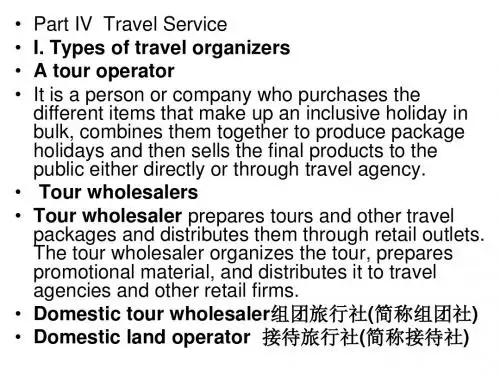
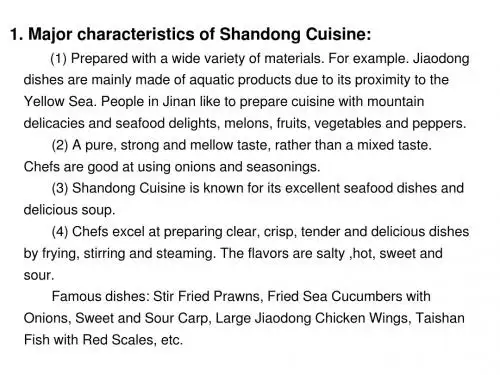
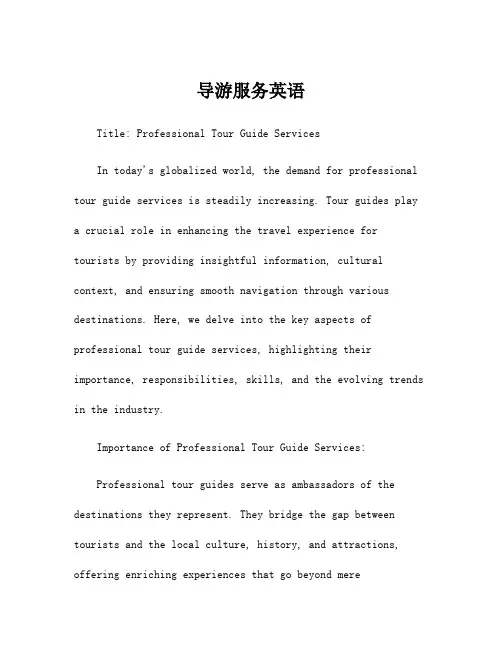
导游服务英语Title: Professional Tour Guide ServicesIn today's globalized world, the demand for professional tour guide services is steadily increasing. Tour guides play a crucial role in enhancing the travel experience fortourists by providing insightful information, cultural context, and ensuring smooth navigation through various destinations. Here, we delve into the key aspects of professional tour guide services, highlighting their importance, responsibilities, skills, and the evolving trends in the industry.Importance of Professional Tour Guide Services:Professional tour guides serve as ambassadors of the destinations they represent. They bridge the gap between tourists and the local culture, history, and attractions, offering enriching experiences that go beyond meresightseeing. Their expertise adds value by providing context, anecdotes, and behind-the-scenes insights that make the journey memorable and meaningful.Responsibilities of Tour Guides:Tour guides shoulder diverse responsibilities to ensure a seamless and enjoyable travel experience for their clients. These responsibilities include:1. Knowledge Dissemination: Tour guides must possess in-depth knowledge about the destinations they cover, including historical facts, cultural nuances, and current events. They convey this information in an engaging and accessible manner to enrich the tourists' understanding.2. Safety and Security: Ensuring the safety and security of tourists is paramount. Tour guides must be vigilant, aware of potential risks, and equipped to handle emergencies effectively. They also provide guidance on local customs and etiquette to prevent misunderstandings or discomfort.3. Itinerary Management: Tour guides meticulously planand execute travel itineraries, taking into account factors such as time constraints, logistical challenges, and tourist preferences. Flexibility is key, as they may need to adapt plans based on unforeseen circumstances.4. Interpretation and Communication: Effective communication is essential for tour guides to connect with diverse groups of tourists. They must be proficient inmultiple languages, adept at interpreting cultural nuances, and skilled in engaging audiences of varying ages and backgrounds.5. Customer Service: Tour guides prioritize customer satisfaction by addressing queries, resolving issues promptly, and fostering a welcoming atmosphere. Their warmth, enthusiasm, and professionalism leave a lasting impression on tourists, encouraging repeat visits and positive reviews.Skills Required for Tour Guides:Successful tour guides possess a unique blend of skills that enable them to excel in their role. These skills include:1. Cultural Competence: Understanding and respecting cultural diversity is essential for tour guides to interact sensitively with tourists from different backgrounds.2. Communication Skills: Clear, articulate communication enhances the tour experience and fosters rapport withtourists. Tour guides must convey information effectively, tailoring their approach to suit the audience.3. Leadership Abilities: Tour guides lead groups through unfamiliar environments with confidence and authority, demonstrating leadership qualities such as decisiveness, adaptability, and problem-solving skills.4. Flexibility: Tour guides must adapt to changing circumstances, such as weather disruptions or unexpected closures, while maintaining a positive attitude andminimizing inconvenience for tourists.5. Time Management: Efficient time management ensuresthat tours run smoothly and cover all planned attractions within the allocated timeframe, maximizing the tourist's experience.6. Storytelling Skills: Captivating storytelling brings destinations to life, sparking the imagination of tourists and fostering a deeper appreciation for the places visited.Evolving Trends in Tour Guide Services:The tour guide industry is evolving in response to changing traveler preferences and technological advancements. Key trends include:1. Personalized Experiences: Tourists increasingly seek customized experiences tailored to their interests and preferences. Tour guides adapt by offering niche tours focused on specific themes, activities, or demographics.2. Sustainable Tourism: There is growing awareness of the environmental and cultural impact of tourism. Tour guides promote responsible travel practices, such as minimizing waste, supporting local communities, and respecting natural habitats.3. Digital Integration: Technology enhances the tour experience through multimedia presentations, virtual reality tours, and interactive apps. Tour guides leverage these tools to engage and educate tourists in innovative ways.4. Remote Guiding: Virtual tours conducted via video conferencing platforms allow tour guides to reach a global audience without physical travel. This trend gained momentum during the COVID-19 pandemic and continues to offer opportunities for remote guiding services.5. Professional Development: Tour guides invest in continuous learning and skill development to stay abreast ofindustry trends, enhance their expertise, and deliver exceptional service to clients.Conclusion:Professional tour guide services play a pivotal role in shaping memorable and enriching travel experiences for tourists worldwide. With their expertise, passion, and dedication, tour guides contribute to cultural exchange, promote sustainable tourism practices, and create lasting connections between people and places. As the industry evolves, tour guides remain committed to delivering personalized, immersive, and unforgettable journeys that inspire and educate travelers from around the globe.。
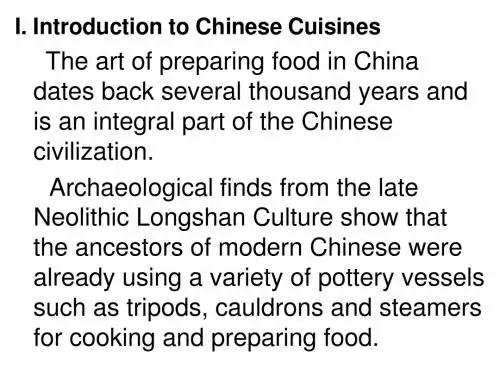
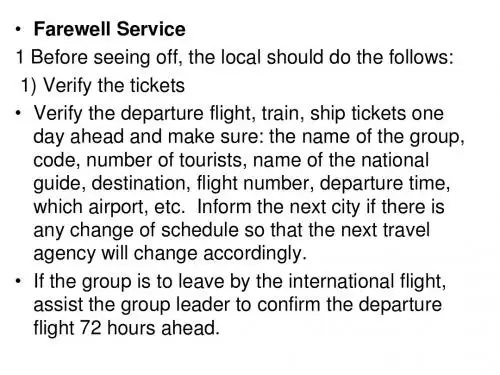


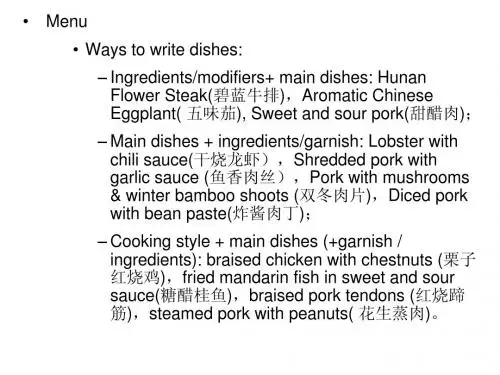



《导游服务规范》英文版Part one1. What should a local guide do before meeting the tour group?(1) Make sure the arrival time of the tourists’ vehicle;(2) Contact the bus driver;(3) Verify the exact time of tourist’s arrival;(4) Inform the baggage clerk;(5) Before the tour group comes out, stand at a visible place where passengers’ exit, with receiving sign held high in the hand.2. When tour group arrive by a vehicle, what should a local guide do?(1) Recognize the tour group;(2) Count the number of the group;(3) check the baggage and hand it over(4) Gather the tourists and help them to get on the bus.3. What should a local guild do on the way to the hotel?(1) Address a welcome speech;(2) Adjust the time;(3) Explain on the way;(4) Inform the meeting time and location.4. What information should be included in the first explanation along the way?(1) Scene introduction. Introduce the main buildings attractions and scenes along the way;(2) customs and habits guide 。
Table MannersOf course, the main difference on the Chinese dinner table is chopsticks instead of knife and fork, but that’s only superficial. Besides, in decent restaurants, you can always ask for a pair of knife and fork, if you find the chopsticks not helpful enough. The real difference is that in the West, you have your own plate of food, while in China the dishes are placed on the table and everyone shares. If you are being treated to a formal dinner and particularly if the host thinks you’re in the country for the first time, he will do the best to give you a taste of many different types of dishes. The meal usually begins with a set of at least four cold dishes, to be followed by the main courses of hot meat and vegetable dishes. Soup then will be served (unless in Guangdong style restaurants) to be followed by staple food ranging from rice, noodles to dumplings. If you wish to have your rice to go with other dishes, you should say so in good time, for most of the Chinese choose to have the staple food at last or have none of them at all. Perhaps one of the things that surprises a Western visitor most is that some of the Chinese hosts like to put food into the plates of their guests. In formal dinners, there are always “public” chopsticks and spoons for this purpose, but some hosts may use their own chopsticks. This is a sign of genuine friendship and politeness. It is always polite to eat the food. If you do not eat it, just leave the food in the plate. People in China tend to over-order food, for they will find it embarrassing if all the food is consumed. When you have had enough, just say so. Or you will always overeat!Table Manners in the WestWhen men and women are eating together, in the home or out of it, the men should pull out the chairs for the women and see that all the ladies are seated before taking their own places. After sitting down, one pulls his chair up and sits close to the table. In many Christian homes it is customary to say grace before the meal begins. Guests should watch the host or hostess and if they bow their heads, they should join them. As soon as grace is finished, or if grace is not said, when the hostess takes her napkin, each one at the table opens his napkin in half and lays it across his lap.When using the silverware, one should begin from the outside piece, then the next knife and fork for the second course and so on. The pieces closest tothe plate are for the last course.When having soup, the diner should move the spoon away from him to spoon out the soup. When the soup gets short toward the end, the side close to the diner can be slightly raised.The diners are not supposed to cut large pieces of food, such as steak or chops, into small pieces all at one time. Only one or two bites are cut as one eats. Some people find it difficult to cut meat. That is because they don’t use their knives close to the forks. When one has finished eating something, the knife and fork should be put diagonally on the further side of the plate. They should not be placed leaning on the plate. The knife should always be placed with the sharp edge in.Americans and Europeans differ in their use of forks when eating. When Americans have finished cutting, they put the knife down, transfer the fork to the right hand and eat. But Europeans hold their forks in the left hand and carry food on the back of the fork.One can choose whichever one likes. However, the American way seems to be easier for those who are not accustomed to eating foreign food. They cannot put food on the back of the fork skillfully. They have to carry food to the mouth so cautiously as not to drop it! But they often drop it. According to the European custom, one puts some solid piece of food at the edge of the fork and pile soft food on it. The American way may seem less efficient, but it is easier and makes one look less clumsy in using fork and knife! American Table MannersThe Role of Manners?There is not much call for a complete working knowledge of table manners in America today. Many families only gather all at once around the dinner table at holiday feasts, and most restaurants are too casual to require, or even to allow for, more than basic good table manners. If, having dropped his napkin, a diner at a bistro were to attempt to practice proper etiquette by signaling a member of the staff to bring a fresh one, he would probably have to do without a napkin at all. Try as he might to make eye contact and indicate the nature of the problem with a subtle wiggle of the eyebrow and downward flicker of the glance, he is likely to succeed only in causing his date to think he is making a play for the server. Although strict good manners forbid placing a used eating utensil back on the table, the server removing a plate onwhich a fork has quite properly been positioned "pointing at 11 o'clock" might just plop that item back where it started, making more of a clatter than if the diner had simply done it herself.From time to time -- perhaps at an important business dinner, a romantic date at an expensive restaurant, or a first dinner with the family of the person who may be "the One" -- it is necessary to display a more sophisticated knowledge of table etiquette. This is not difficult, once you have mastered the basics. Anyone armed with this core knowledge and the ability to adapt smoothly to the situation at hand will be able to handle even the most formal event. The goal is not, after all, to demonstrate utter mastery of the most arcane details of etiquette (which would be quite difficult considering the wide variations of customs in different cultures and from generation to generation), but rather to behave with graciousness and poise at the table.Mastering the BasicsMuch of the difficulty encountered in learning table manners derives from the struggle to master the ritual handling of the various tools involved. In order to display the right social veneer, it is necessary to sit at the table with elegant ease and wield the utensils with aplomb. The diner who leaves the napkin folded on his plate until it obstructs the placement of his appetizer plate reveals his lack of training. The dinner party guest who observes with dismay the array of flatware on either side of her plate, need only take the time to learn the simple secret to the plan. There are, of course, a few tips and pitfalls to be aware of, as well as the occasional surprising item you can eat with your hands. Here is a quick guide which will help steer you through even the most formal of occassions.。